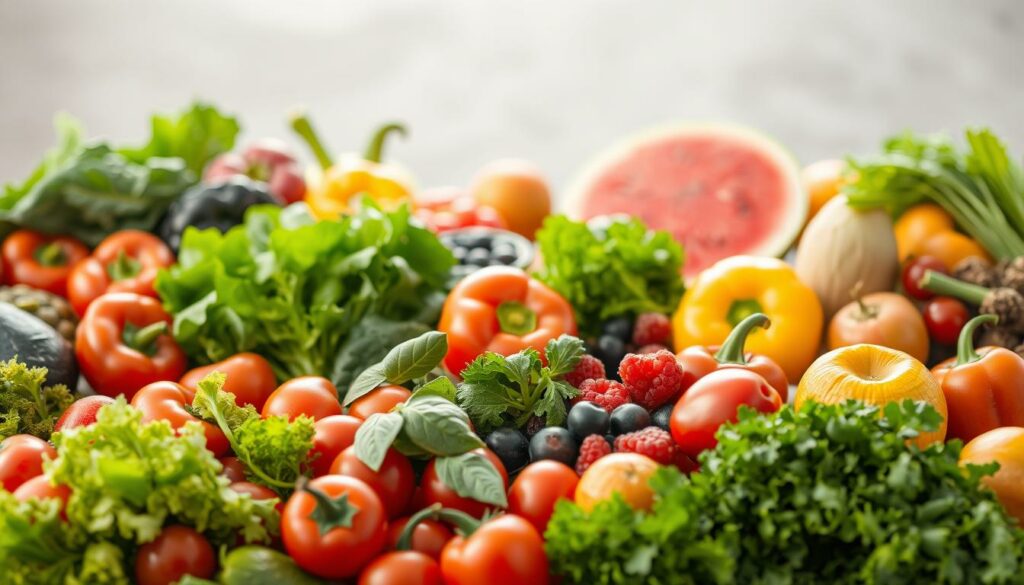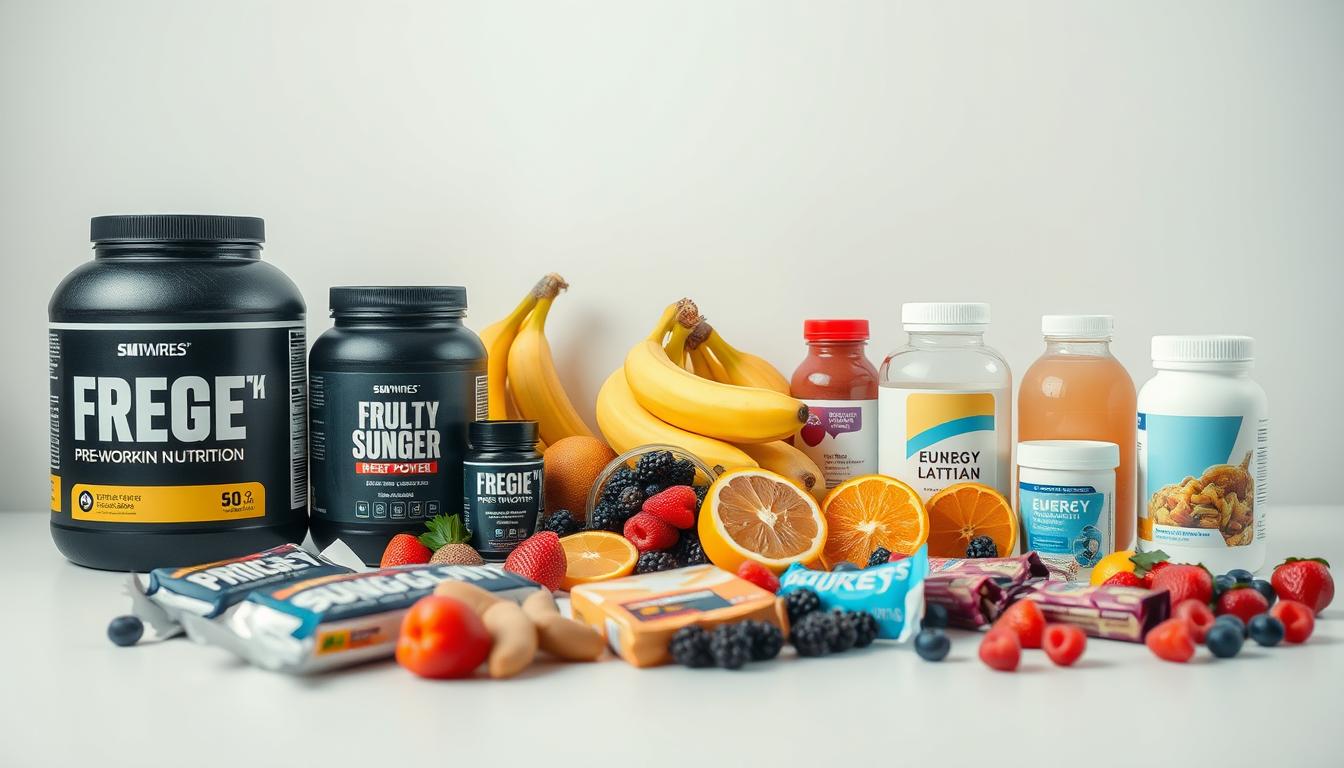Eating less without feeling deprived is a common challenge. Many struggle to reduce calorie intake. It’s key to adopt healthy eating habits for weight loss and better health.
By choosing nutrient-dense foods and practicing mindful eating, you can lose weight without feeling hungry all the time. This method helps you develop a healthier relationship with food. It also supports lasting eating habits.
Key Takeaways
- Mindful eating can help reduce hunger.
- Nutrient-dense foods support weight loss.
- Healthy eating habits are key for overall well-being.
- Reducing calorie intake doesn’t mean feeling hungry.
- Sustainable eating habits lead to long-term success.
Understanding Hunger and Satiety Signals
The human body has a complex system for managing hunger and fullness. It’s influenced by physical and psychological factors. Knowing these signals is key to eating less without feeling hungry. By telling true hunger from emotional triggers, people can control their appetite better.
Physical vs. Psychological Hunger
It’s important to know the difference between physical hunger and psychological hunger. Physical hunger is when your body needs food for energy. It shows signs like a growling stomach or feeling dizzy.
Recognizing True Hunger Cues
True hunger cues tell your body it needs food for energy. These signs include:
- Stomach growling
- Feeling lightheaded or dizzy
- Irritability or mood swings
- Difficulty concentrating
Emotional Triggers That Mimic Hunger
Emotional triggers can make you feel hungry when you’re not. Common ones are:
- Stress
- Boredom
- Feeling sad or anxious
Knowing these triggers is the first step to managing them.
How Your Body Regulates Appetite
The body’s appetite is controlled by hormones like ghrelin, leptin, and insulin.

Ghrelin makes you hungry, while leptin makes you feel full. Understanding this balance helps manage hunger.
Common Hunger Triggers Beyond Nutritional Needs
Many things can make you feel hungry, not just when you need food. These include:
- Lack of sleep
- Dehydration
- Certain medications
Knowing these can help you find ways to control hunger better.
High-Volume, Low-Calorie Foods That Fill You Up
High-volume, low-calorie foods are great for dieters. They make you feel full without adding too many calories. These foods are good for losing weight and keeping you healthy.
Water-Rich Fruits and Vegetables
Water-rich fruits and veggies are perfect for staying full without too many calories. They have lots of water, which makes you feel full.
Best Produce Options for Maximum Fullness
Cucumbers, tomatoes, and watermelon are top picks for feeling full. They’re low in calories but packed with vitamins and minerals.
- Cucumbers: Low in calories and high in water content, making them very filling.
- Tomatoes: Rich in water and fiber, tomatoes can help reduce hunger.
- Watermelon: With its high water content, watermelon is both refreshing and filling.

Fiber-Packed Options for Lasting Fullness
Fiber is key for feeling full and staying that way. Foods high in fiber take longer to digest, keeping you satisfied longer.
Soluble vs. Insoluble Fiber Benefits
Soluble and insoluble fiber both help with feeling full. Soluble fiber, like in oats and barley, slows digestion. Insoluble fiber, in whole grains and veggies, helps with digestion and adds bulk.
| Fiber Type | Food Sources | Benefits |
|---|---|---|
| Soluble Fiber | Oats, Barley, Fruits | Slows digestion, helps lower cholesterol |
| Insoluble Fiber | Whole Grains, Vegetables | Adds bulk, aids in regular bowel movements |
Protein-Rich Foods That Increase Satiety
Protein helps you feel full and satisfied. Adding protein-rich foods to your diet can help with weight management.
Plant and Animal Protein Comparisons
Both plant and animal proteins are good. Plant proteins, like in legumes and nuts, have fiber. Animal proteins, in lean meats and fish, have essential amino acids.
- Legumes: High in protein and fiber, making them very satiating.
- Lean Meats: Rich in protein, low in fat, ideal for weight loss.
- Nuts and Seeds: Provide protein and healthy fats, contributing to feelings of fullness.
Adding these foods to your diet helps manage hunger and supports weight loss.
Strategic Meal Timing and Frequency
Meal timing and frequency are key to controlling hunger and metabolism. Knowing how to space out meals helps manage appetite and supports health goals.
The Science Behind Meal Spacing
The body has a system to control hunger and fullness, using hormones like ghrelin and leptin. Ghrelin increases hunger before eating and drops after. Leptin helps keep energy balance, making you feel full.
Studies show eating smaller, more frequent meals keeps energy stable and reduces hunger. But, the best frequency and timing vary by person, lifestyle, and diet.
Intermittent Fasting Approaches
Intermittent fasting (IF) is popular for managing weight and improving health. It involves fasting or eating less, then eating freely.
Popular Methods and Their Benefits
There are many IF methods, each with benefits. The 16/8 Method means fasting 16 hours, eating in 8. The 5:2 Diet limits calories to 500-600 on two days a week. These can improve insulin sensitivity, autophagy, and weight loss.
- 16/8 Method: Makes meal planning easier and boosts insulin sensitivity.
- 5:2 Diet: Offers flexibility and can lead to weight loss.
- Alternate Day Fasting: Can cause significant weight loss and better heart health.
Pre-Planning Meals to Control Portions
Planning meals ahead helps control portions and hunger. It ensures balanced, nutritious foods are eaten.
Meal Prep Techniques for Portion Management
Meal prep means cooking in bulk, portioning, and storing meals. It saves time and keeps portions consistent. Using portion-sized containers helps manage food intake.
Combining meal timing with portion-controlled meals leads to a healthier food relationship. It helps reach dietary goals more effectively.
How to Eat Less Without Feeling Hungry: Practical Techniques
To eat less without feeling hungry, mix mindful eating with portion control. These steps help you eat better and manage your weight. They also boost your overall health.
Mindful Eating Practices
Mindful eating means focusing on your food. Notice the colors, smells, and tastes. Also, pay attention to when you’re hungry or full.
Slowing Down Your Eating Pace
Eating slowly helps you feel full sooner. Put your fork down between bites and drink water. This slows you down.
Eliminating Distractions During Meals
Turn off the TV and put away your phone. Focus on your meal and the people you’re with. This makes eating better.
Portion Control Strategies That Work
It’s key to control how much you eat. Use measuring cups or a food scale. This shows you what a serving size is.
| Food | Standard Serving Size | Calories |
|---|---|---|
| Pasta | 1/2 cup cooked | 100 |
| Chicken Breast | 3 oz | 140 |
| Broccoli | 1 cup chopped | 55 |
Using Smaller Plates and Utensils
Smaller plates and utensils make you eat less. They make your food look bigger. This can help you eat fewer calories.
Hydration Strategies to Reduce Appetite
Hydration is often overlooked as a way to reduce appetite. Yet, it can be very effective. Sometimes, thirst is mistaken for hunger, leading to extra calories. By using the right hydration strategies, people can better control their appetite and help with weight management.
Water Consumption Timing for Maximum Effect
Drinking water at the right times can really help. Pre-meal hydration is key because it can cut down on calories during meals.
Hydrating Foods and Beverages
Drinking water is not the only way to stay hydrated. Eating foods and drinking beverages with high water content also helps. Foods like cucumbers, watermelon, and celery provide hydration and important nutrients.
| Food | Water Content (%) | Nutritional Benefits |
|---|---|---|
| Watermelon | 92 | Rich in Vitamin C and lycopene |
| Cucumber | 96 | Good source of potassium and antioxidants |
| Celery | 95 | High in Vitamin K and folate |
Avoiding Liquid Calories
It’s important to avoid liquid calories to manage weight. Drinks with sugar and high calories can add a lot of calories without making you feel full like solid foods do.
Hidden Sources of Drinkable Calories
Many drinks, like flavored coffees and smoothies, have a lot of calories. Knowing about these hidden sources helps make better choices and avoid extra calories.
Managing Emotional and Stress Eating
It’s important to know how emotions affect our eating habits. Eating due to emotions, not hunger, can harm our diet and health.
Identifying Emotional Eating Triggers
Finding out what makes you eat emotionally is the first step. It could be stress, boredom, or certain memories.
Creating a Food-Mood Journal
Keeping a food-mood journal helps find these triggers. Write down what you eat and how you feel. This can show patterns that lead to emotional eating.
| Emotional State | Common Triggers | Healthier Alternatives |
|---|---|---|
| Stress | Work pressure, deadlines | Meditation, short breaks |
| Boredom | Lack of activities, monotony | Engaging in hobbies, exercise |
| Anxiety | Uncertainty, fear of the future | Deep breathing, planning |
Healthy Alternatives to Comfort Foods
After finding triggers, choose better foods. Pick fruits or nuts over junk snacks. Exercise can also help with stress.
Stress-Reduction Techniques That Decrease Hunger
Stress-reducing activities are key. Try meditation, yoga, or deep breathing to lower stress.
Quick Practices for Immediate Relief
For quick stress relief, try a short walk or some stretching. A few minutes of meditation can also help.
By tackling emotional eating, you can eat better and feel better overall.
Smart Kitchen and Dining Habits
Your kitchen and dining habits can either help or hurt your goal to eat less without feeling hungry. A tidy kitchen and a mindful dining space are key for healthy eating.
Organizing Your Kitchen for Success
First, set up a system for managing your food. Use clear containers for storage, label leftovers, and follow a “first-in, first-out” rule for fresh items.
Strategic Food Placement and Storage
Put healthier foods at eye level in your pantry and fridge. This makes them easier to grab than unhealthy options. Use a food storage chart to keep track of what you have.
| Food Type | Storage Location | Benefits |
|---|---|---|
| Fruits and Vegetables | Visible containers on countertops | Encourages healthy snacking |
| Whole Grains | Easy-to-reach pantry shelves | Promotes whole grain consumption |
Dining Environment Adjustments
Eat in a place without distractions, like turning off the TV and putting away your phone. This helps you focus on your meal and know when you’re full.
“The way we eat is just as important as what we eat. Creating a mindful dining environment can lead to a healthier relationship with food.”
Using smaller plates and utensils can also help control how much you eat.
Restaurant Strategies for Controlled Eating
Choose restaurants with healthy options and be mindful of portion sizes. This is a key strategy.
Menu Navigation and Ordering Tips
Opt for grilled, baked, or steamed menu items and avoid heavy sauces or fried foods. Consider sharing a meal or asking for a to-go box to pack up half your meal before eating.
Physical Activity’s Role in Appetite Regulation
The link between physical activity and appetite is complex. It might seem odd, but regular exercise can help reduce hunger. It also supports weight loss efforts.
Exercise Types That Suppress Hunger
Not all exercises affect hunger the same way. Aerobic exercises, like running or cycling, are better at reducing hunger. This is because they trigger the release of hormones that lower appetite.
- Aerobic exercises like jogging or swimming
- High-Intensity Interval Training (HIIT)
- Resistance training with compound exercises
Timing Workouts for Appetite Control
When you exercise matters for controlling hunger. The right time can make your workouts more effective at reducing hunger.
Optimal Exercise Windows
Studies show morning exercise is best for controlling appetite. It helps regulate your body’s rhythms and boosts metabolic health.
Balancing Activity and Calorie Reduction
Exercise is key for health, but it’s also important to cut calories for weight loss. Compensatory eating after workouts can undo the calorie burn from exercise.
Avoiding Compensatory Eating After Workouts
To prevent overeating after exercise, plan your meals and snacks. Choose foods that are full of nutrients but low in calories.
Understanding how physical activity affects hunger and planning your exercise can help manage hunger. This supports your weight loss goals.
Conclusion: Sustainable Approaches to Eating Less
Adopting sustainable eating habits is key for a healthy food relationship and less calorie intake. Understanding hunger and fullness signals is important. Also, eating high-volume, low-calorie foods and being mindful while eating helps.
Strategies like meal timing, staying hydrated, and managing emotional eating help eat less without feeling hungry. These practices make daily life healthier and improve nutrition.
Good nutrition advice focuses on lasting lifestyle changes, not quick fixes. Sustainable eating builds a healthier food relationship and keeps diets balanced over time.
Starting these strategies takes commitment and patience. But, the rewards of a healthier lifestyle are worth the effort.
FAQ
What are some high-volume, low-calorie foods that can help me feel full?
Foods like water-rich fruits and veggies, and fiber-rich broccoli and carrots, can fill you up. Also, protein-rich foods like chicken and fish are good choices without too many calories.
How can I differentiate between true hunger and emotional triggers?
Listen to your body’s hunger signals like stomach growling. Be aware of feelings like stress or boredom that might make you feel hungry.
What is the role of hydration in managing hunger?
Drinking water and eating hydrating foods helps manage hunger. Avoiding drinks with calories also supports weight loss.
How can I manage emotional and stress eating?
Know what triggers your emotional eating. Find healthier comfort foods. Try stress-reducing activities like meditation or deep breathing.
What are some effective portion control strategies?
Use smaller plates and utensils. Plan your meals ahead. Practice mindful eating to control portions and eat less.
How does physical activity impact appetite regulation?
Exercise, like aerobic activities, can reduce hunger. Timing workouts right can help control appetite. Balancing exercise with eating less supports weight loss.
What are some smart kitchen and dining habits that can support healthy eating?
Organize your kitchen and dining area. Use strategies like menu planning when eating out. These habits support healthy eating.
How can meal timing and frequency impact hunger and satiety?
Space out your meals and try intermittent fasting. Pre-planning meals helps manage hunger and supports health.
What is mindful eating, and how can it help me eat less?
Mindful eating means eating slowly, without distractions. Pay attention to hunger and fullness cues. This helps you eat less and develop better eating habits.


